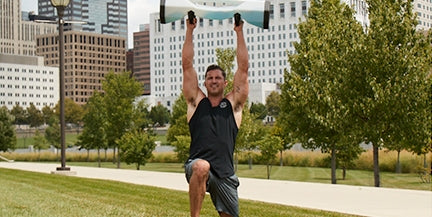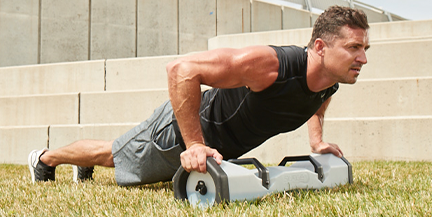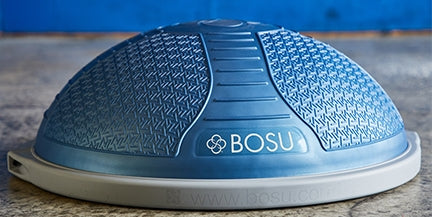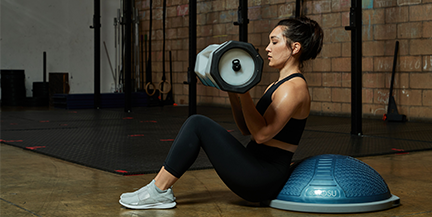The Iron Knee - Injury Prevention with the BOSU® Balance Trainer
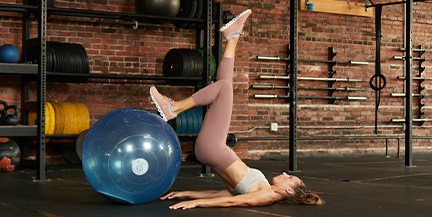
To build the Iron Knee, you must first understand an important paradox! While it is the largest joint in the human body, the knee itself is not necessarily strong. It is the soft tissue and connective tissue (muscles, ligaments and tendons that gives it strength and stability. The knee joins the thigh with the lower leg and consists of two joints: One between the femur and tibia (Tibiofemoral Joint) and one between the femur and patella (Patellofemoral joint). It is a modified hinge joint which permits flexion and extension as well as slight internal and external rotation. That being said, the knee is a stable joint moving predominantly in the sagittal plane, with the hip above and ankle below, both offering mobility in all three planes of motion.
People often exclaim, “I have weak knees!” or “I have a knee problem!” However, more often than not, knee pain is a symptom rather than the cause of a problem, unless there’s a congenital malformation, disease or a trauma, such as a torn ACL or meniscus. Knee pain may be symptomatic of a foot, ankle or hip moving poorly, muscle weakness, tightness or repetitive stress. Whatever the reason, this alters movement patterns and creates dysfunction. Muscle recruitment and joint movement is altered, ultimately causing a muscle imbalance.
A muscle imbalance occurs when there is a lack of balance between different muscles, or an alteration in the functional relationship between pairs or groups of muscles, such as the balance between the hamstrings, gluteal muscles and the psoas and adductors. This tendency is typically systematic. Certain muscles are prone to shortening (tightness) while other muscles are susceptible to lengthening and weakness (inhibition). The combination of tight and weak muscles can alter normal movement patterns resulting in an alteration of the biomechanics of joints leading to degeneration in the knee.
In the chart below, the list outlines the muscles affecting the knee that are typically shortened due to tightness and the muscles that are frequently lengthened and inhibited or underactive. Tightness and inhibition effects the length-tension relationships of the muscles or the resting length of a muscle and the tension the muscle can produce at this resting length. In turn, the length-tension relationship of a muscle impacts the force-couple or the synergistic action of muscles to produce movement around a joint. It’s a vicious cycle since the muscle-tendon units will shorten or lengthen as the stressors that are placed on the body demand.
Muscles Prone to Shortening and Lengthening Affecting the Knee
|
Frequently Shortened Muscles (tightness) |
Frequently Lengthened Muscles (Inhibited) |
|
Gastrocnemius |
Anterior tibialis |
|
Soleus |
Posterior tibialis |
|
Adductors |
Vastus Medialis Oblique |
|
Hamstrings |
Gluteus Maximus |
|
Psoas |
Gluteus Medius |
|
Tensor Fascia Latae |
|
|
Rectus femoris |
|
|
Piriformis |
|
The purpose of this series of exercises is to address common muscle imbalances to provide you with some effective strategies to enhance lower extremity function, thereby ‘strengthening’ the knees. Therein lies the irony, since again, it’s not the knee itself that is strengthened! Instead, to improve lower extremity efficiency and decrease potential injuries, its more about establishing normal length-tension relationships, which ensures proper length and strength of the muscles functioning around the joint. This is achieved through key strengthening and stretching movement patterns.
This integrated approach focuses on the joints and respective muscles above the knee, such as the gluteal muscles, piriformis, the psoas, rectus femoris and adductors, as well as the muscles that pull directly on the joint itself, such as the gastrocnemius, hamstrings, vastus medialis oblique and the muscles that effect the ankle, like the soleus (and gastrocnemius), and the anterior and posterior tibialis. Since this article centers around strength and conditioning, there is a smaller focus on mobility, providing you with a mobility matrix of strategic stretches for key muscle groups. The videos demonstrate a few great movement progressions designed to reestablish muscle balance and enhance function.
Perform each movement at the appropriate level for 10 - 15 repetitions per side. Focus on quality movement, with good overall body control and balance. Some of the progressions move toward power with explosive variations. Work up to these movements making sure that you can execute each level smoothly before you move to the next. With the mobility matrix, work in a pain-free range of motion. Move in and out of each stretch smoothly, avoiding any jerky or sudden movements. Stretch to a mild point of tension and focus on breathing with each move.
Note: These exercises may be performed with or without footwear. Learn each matrix while wearing supportive footwear for more stability, and progress to minimal footwear for more balance challenge. If exercising in bare feet, keep a towel handy to wipe sweat off the dome or floor as they may become slippery when wet.
Lunge Matrix in the Sagittal Plane with BOSU® Balance Trainer and Balance Bar
- Front Lunge to Step Up / Rear Lunge from dome to floor with Balance Bar
- Front Lunge to Step Up / Rear Lunge from dome to floor with no Balance Bar assistance
- Front Leap to balance / Leap back to balance
Lunge Matrix in the Frontal Plane with BOSU® Balance Trainer and Balance Bar
- Side Lunge from floor to dome with Balance Bar
- Side Lunge to Lateral Step Up and down with Balance Bar
- Side to Side Lunge, dome to floor, floor to dome with power
Single Leg Dead Lift Progression with BOSU® Balance Trainer and Ballast® Ball
- Single Leg Dead Lift, rear foot kickstand, touch Balance Trainer (Platform Side Up) PSU
- Single Leg Dead Lift, rear foot kickstand, pick up Balance Trainer PSU
- Single Leg Dead Lift pick up Balance Trainer PSU with Ballast® Ball under back foot
Bridge Hamstring Progression with BOSU® Ballast® Ball and Balance Bar
- Supine Bridge / Curl, feet on Ballast® Ball, hands on floor
- Supine Bridge / Curl, feet on Ballast® Ball, Balance Bar on hips, elbows down
- Supine Bridge / Curl, feet on Ballast® Ball, Balance Bar held up
Mobility Matrix with BOSU® Balance Trainer
Psoas, Quadriceps, Hamstring and Piriformis Stretch into calf before repeating on the other side. Flow of dynamic and static stretches and mobility repeat a few times on each side
Keli Roberts is a member of the BOSU® Development Team and creates workshops and workout programs for fitness professionals. She is a Master Trainer for BOSU®, SURGE®, Schwinn®, and Precision Nutrition, as well as a Certified Cancer Exercise Specialist.
References:
(1) Janda V. On the concept of postural muscles and posture in man. Aust J Physiother. 1983;29(3):83-84
(2) Powers CM. The influence of altered lower-extremity kinematics on patellofemoral joint dysfunction: a theoretical perspective J Orthop Sports Phys Ther. 2003;33(11):1840-1844
(3) Janda V. Muscle Strength in Relation to Muscle Length, Pin and Muscle Imbalance. In: Harms-Ringdahl, ed. International Perspectives in Physical Therapy VIII. Edinburgh: Churchill Livingstone; 1993: 83-91
(4) Janda V., “Muscles and Motor Control in Low Back Pain: Assessment and Management” in Twomey LT, ed. Physical Therapy of the Low Back, pp. 253-278.
(5) Edgerton VR, Wolf SL, Levendowski DJ, Row RR, Theoretical basis for patterning EMG amplitudes to assess muscle dysfunction. Med Sci Sports Exerc1996;28(6):744-751

